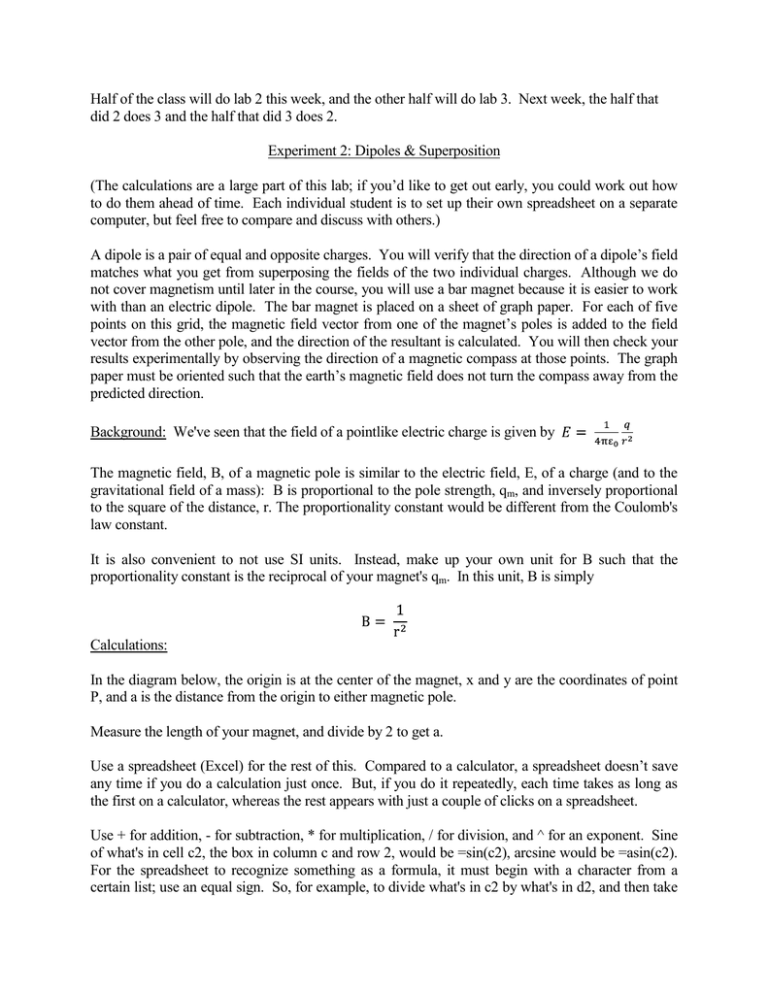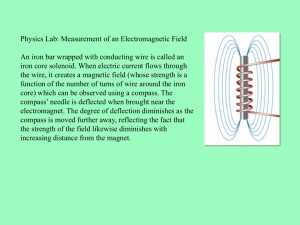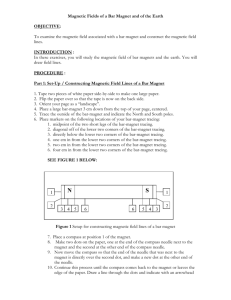Document 11698976
advertisement

Half of the class will do lab 2 this week, and the other half will do lab 3. Next week, the half that did 2 does 3 and the half that did 3 does 2. Experiment 2: Dipoles & Superposition (The calculations are a large part of this lab; if you’d like to get out early, you could work out how to do them ahead of time. Each individual student is to set up their own spreadsheet on a separate computer, but feel free to compare and discuss with others.) A dipole is a pair of equal and opposite charges. You will verify that the direction of a dipole’s field matches what you get from superposing the fields of the two individual charges. Although we do not cover magnetism until later in the course, you will use a bar magnet because it is easier to work with than an electric dipole. The bar magnet is placed on a sheet of graph paper. For each of five points on this grid, the magnetic field vector from one of the magnet’s poles is added to the field vector from the other pole, and the direction of the resultant is calculated. You will then check your results experimentally by observing the direction of a magnetic compass at those points. The graph paper must be oriented such that the earth’s magnetic field does not turn the compass away from the predicted direction. Background: We've seen that the field of a pointlike electric charge is given by The magnetic field, B, of a magnetic pole is similar to the electric field, E, of a charge (and to the gravitational field of a mass): B is proportional to the pole strength, qm, and inversely proportional to the square of the distance, r. The proportionality constant would be different from the Coulomb's law constant. It is also convenient to not use SI units. Instead, make up your own unit for B such that the proportionality constant is the reciprocal of your magnet's qm. In this unit, B is simply Calculations: In the diagram below, the origin is at the center of the magnet, x and y are the coordinates of point P, and a is the distance from the origin to either magnetic pole. Measure the length of your magnet, and divide by 2 to get a. Use a spreadsheet (Excel) for the rest of this. Compared to a calculator, a spreadsheet doesn’t save any time if you do a calculation just once. But, if you do it repeatedly, each time takes as long as the first on a calculator, whereas the rest appears with just a couple of clicks on a spreadsheet. Use + for addition, - for subtraction, * for multiplication, / for division, and ^ for an exponent. Sine of what's in cell c2, the box in column c and row 2, would be =sin(c2), arcsine would be =asin(c2). For the spreadsheet to recognize something as a formula, it must begin with a character from a certain list; use an equal sign. So, for example, to divide what's in c2 by what's in d2, and then take the square root, you would type =(c2/d2)^.5 in the cell. When you move elsewhere, the formula no longer appears in the cell, but if you come back, it will be in the box near the top of the screen. Have the spreadsheet’s second row find the direction of B , the magnetic field vector at point P, as follows. (Use the first row for headings.) - Put x and y in the first two columns. (2 and 8) - Find r1 and r2 from x, y, and a. - Find θ1 and θ2 from x, y, and a. (Two problems to avoid: 1. Use arctan not arccos, because arctan makes angles below the horizontal negative but arccos does not. 2. Do not convert to degrees. When Excel uses them in a later column, it will expect them to still be in radians, just the way it first calculated them.) - Find B1 and B2 from r1 and r2. - Find the components of B1 and B2 from B1, B2, θ1 and θ2. (Get the signs right: N is to magnetism what + is to electricity, B B and S is like -. So, 1 points away from the N pole, but 2 points toward the S pole.) - Find the components of B from the components of B1 and B2 . - Find θ, the direction of B relative to the positive x axis, from the components of B . - The spreadsheet uses radians; have it multiply by 57.3 to get degrees. Once the formulas are set up in the second row, copy them down through row six: Highlight your row of formulas. Click Edit then Copy. Highlight the same columns in rows 3 - 6. Click Edit then Paste. The row numbers in your formulas will automatically be adjusted. To experimentally check your results, a sheet has been printed with outlines of the magnet and compass. Use this to see if the magnet makes the compass point in the predicted direction: (The direction of the field is the same as the direction that a compass points.) 1. Place the compass on the sheet so that east on the compass is the x direction, and north on the compass is the y direction. 2. Orient the sheet of paper so that the earth's field does not affect the answer: With the magnet very far away, rotate the sheet until the compass is pointing in the expected direction. Then put the magnet in place. 3. Record the field's direction. (The marks on these little compasses are 15 apart. Don't try to substitute a larger compass; they are easier to read, but the field differs too much between one end of the needle and the other.) Estimate an uncertainty, based on how closely you can read the compass and on how badly it seems to stick. Within the expected level of accuracy, does theory match experiment? PHY 132 Report on Experiment 2: Superposition a = ____________________ x (cm) y (cm) measured θ 2 8 ± 5 2 ± 5 7 ± 10 4 ± 15 3 ± calculated θ State the formula used in each column of the spreadsheet, and explain where each comes from. In most cases, the best explanation would be a diagram. For example, you could just put this picture next to the formula for r1. You don’t need to print the spreadsheet if you keep it on the screen until I accept your paper.





